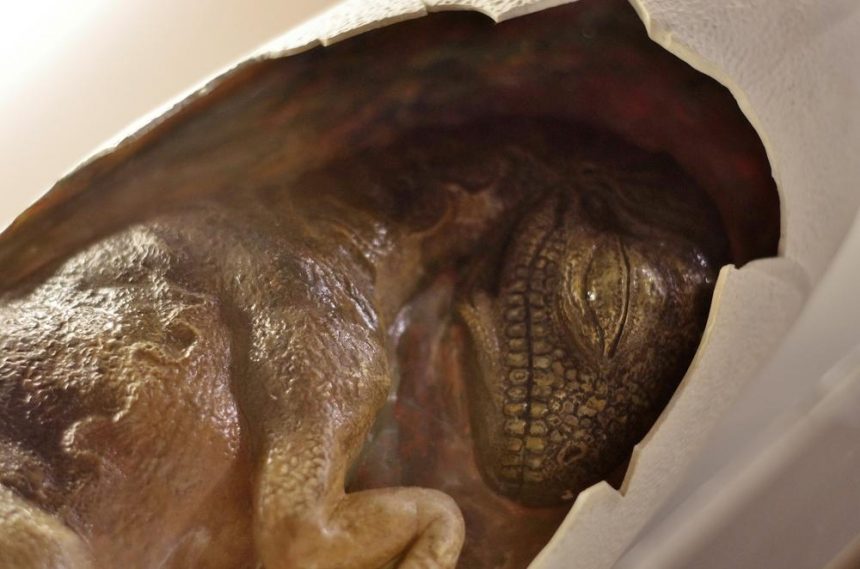In a dimly lit corner of a museum’s storage room in China, a remarkable discovery awaited silently, holding within its age-old shell a tale from a time when giants roamed the Earth. This captivating story begins with the unveiling of an exquisitely preserved dinosaur embryo, nestled snugly inside its fossilized egg for millions of years. Known as Baby Yingliang, this rare find from the Cretaceous period offers a unique glimpse into the world of oviraptorosaurs, a group of feathered dinosaurs that once wandered the planet long before the arrival of humans. The discovery of Baby Yingliang transcends just a snapshot frozen in time; it serves as a window into the evolutionary dance that links the ancient denizens of our world with the avian descendants that share our skies today.
The embryo, measuring approximately 27 centimeters (10.6 inches) in length, was discovered in a pose strikingly similar to that of modern bird embryos just before hatching. This posture, known as tucking, is essential for a bird’s successful escape from the egg. The uncanny resemblance of Baby Yingliang’s position to that of modern birds challenges our understanding of evolutionary connections between ancient dinosaurs and present-day avian species. As we embark on this incredible journey of discovery, let us delve deeper into the mysteries that Baby Yingliang unravels, shedding light on the ancient world and our place within its vast, interconnected history.
The untold story of Baby Yingliang’s discovery is a narrative that intertwines serendipity with the tireless pursuit of knowledge. For years, a fossilized egg lay dormant in a museum storeroom in China, overlooked amidst a sea of relics from a bygone era. Within this egg lay a perfectly preserved dinosaur embryo, a treasure from the late Cretaceous period that would astonish the scientific community and captivate the world. The embryo, belonging to the oviraptorosaurs lineage, was found in a posture reminiscent of modern bird embryos on the brink of hatching. This groundbreaking discovery provided tangible evidence of such behavior in non-avian dinosaurs, bridging a crucial gap between ancient behaviors and their modern avian descendants.
The significance of Baby Yingliang’s discovery lies not only in its exceptional preservation but also in the narrative it weaves, connecting the threads of evolutionary history across millions of years. This tiny dinosaur, frozen in time, imparts valuable insights into the evolutionary journey that shaped the creatures of the past into the birds that soar above us today. Baby Yingliang is not merely a fossil; it is a messenger from the ancient world, whispering secrets of lineage and evolution through the ages.
The posture exhibited by Baby Yingliang in the egg, known as tucking, serves as a profound revelation that stretches across the vast expanse of time, linking ancient dinosaurs to present-day birds. This behavior, critical for the hatching process in modern birds, challenges existing notions of evolutionary timelines and sheds light on the deep-rooted origins of avian characteristics within their dinosaur ancestors. Baby Yingliang’s discovery prompts a reevaluation of avian behaviors and their evolutionary history, painting a vivid picture of the intricate tapestry of life on Earth.
The journey from dinosaurs to birds is a captivating narrative of transformation and resilience, showcasing the adaptability of life over millennia. Feathers, once considered exclusive to birds, have been unearthed in various dinosaur species, indicating a shared ancestry between these groups. The study of fossils like Baby Yingliang unravels the developmental processes of dinosaurs, drawing parallels with the stages of bird development and emphasizing the continuum of evolution across species and ages.
Fossil discoveries, exemplified by Baby Yingliang, play a pivotal role in modern scientific inquiry, offering crucial insights into the history of life on Earth. Each fossil is a piece of the puzzle in understanding the past, the present, and the potential future of our planet. Through the study of fossils, scientists reconstruct ancient ecosystems, trace species lineages, and unravel the intricacies of evolutionary processes that have shaped our world. Fossils are not mere remnants of the past; they are windows into the dynamic history of life, challenging our perceptions and fueling our curiosity to explore the mysteries of our natural world.






